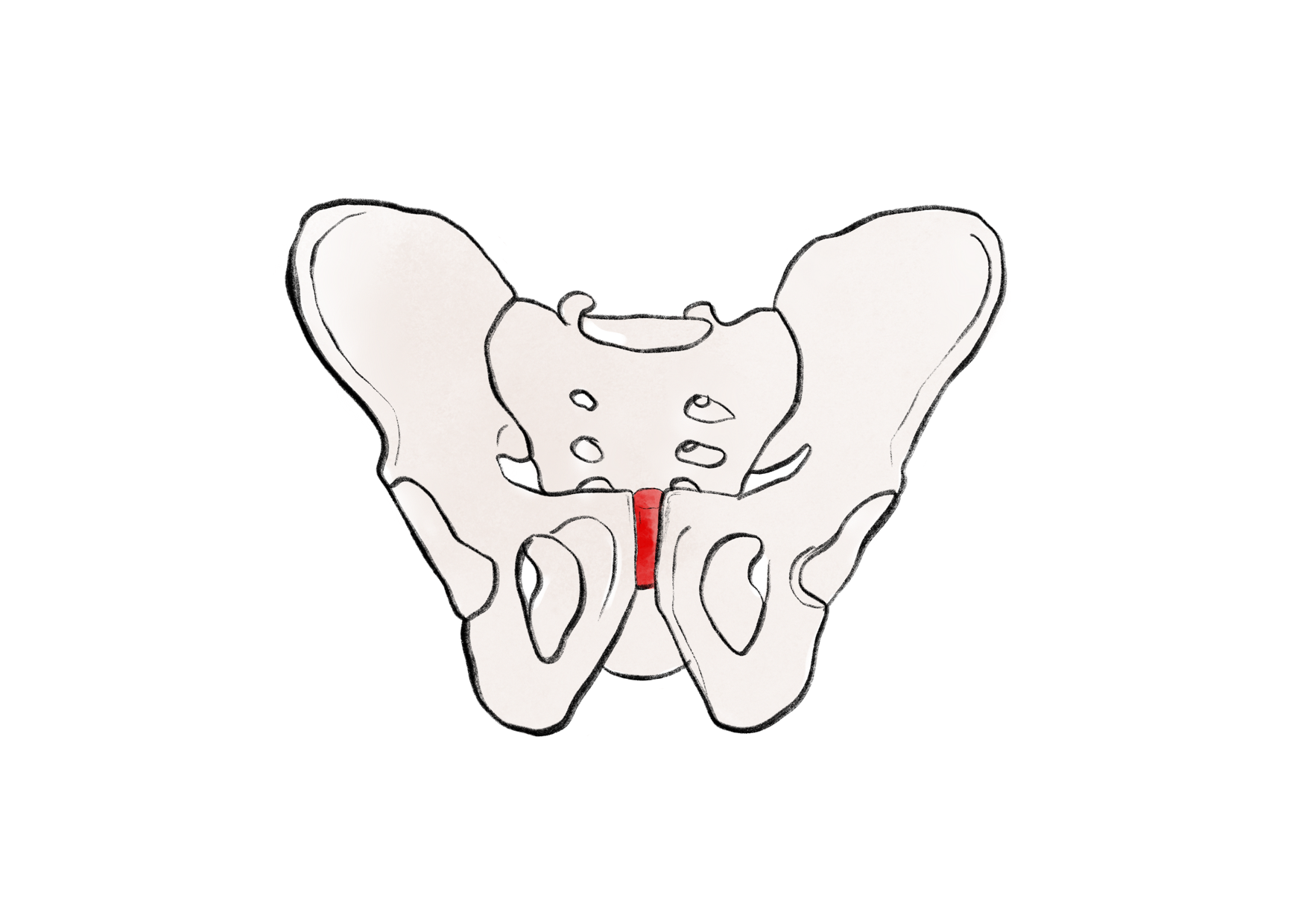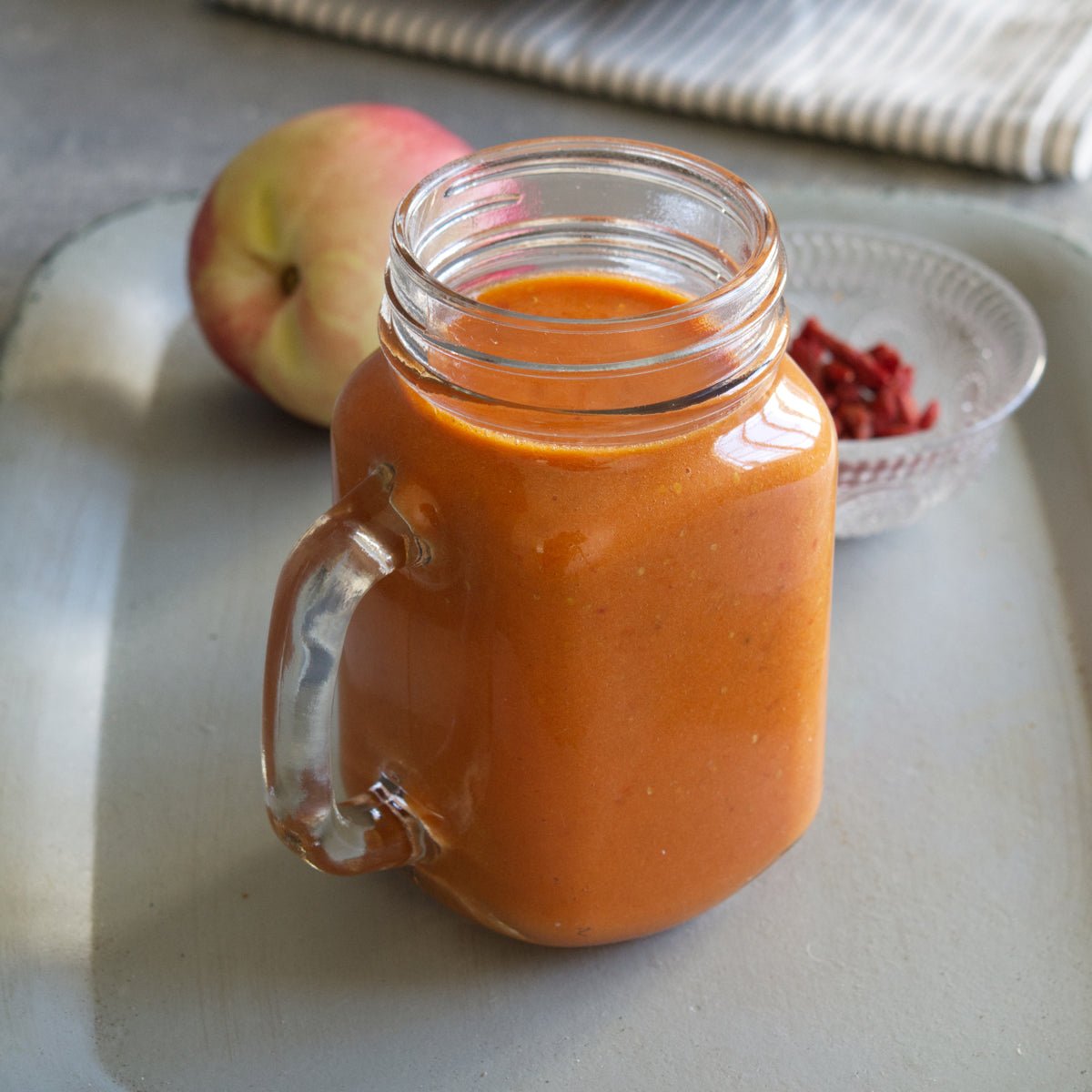Many have it and only a few really talk about it or know that they can do something about it, meaning the loosening of the symphysis. We often only get to know our symphysis when we are confronted with the pain of a growing belly during pregnancy. That uncomfortable pulling in the pubic area that can sometimes be so painful that normal walking, putting on shoes or climbing stairs becomes a challenge.
Where and what is the symphysis?
Our pelvis not only protects some of our internal organs and enables us to walk upright, it is of great importance, especially during pregnancy and childbirth. It consists of a ring of bones and the pelvic floor muscles. The pelvic ring also has three joints: the two sacroiliac joints and the symphysis, also known as the pubic symphysis.
The symphysis connects the left and right pubic bone via a cartilaginous connection.
It usually allows little mobility for the pelvic ring. During pregnancy, however, the female body produces more of the hormone relaxin to prepare for the upcoming birth. This in turn makes the tissue softer and the ligaments more elastic - especially in the area of the symphysis but also in the sacroiliac joints between the ilium and sacrum. This is normal, but it can cause pain if the pubic symphysis dilatation becomes too intense. Then one speaks of symphysis loosening.
Hormonal reasons are cited as the cause of a loosening of the symphysis. In principle, the loosening can also be related to a possible overload of the expectant mother. This overload does not necessarily have to be of a physical nature.
A loosening of the symphysis can also be promoted by undetected structural injuries from previous pregnancies or insufficient regression, which leads to greater overall instability in the pelvic girdle.
Symptoms that may be related to a loosening of the symphysis
- The pubic bone area hurts, sometimes accompanied by pain that radiates from the back into the lateral thighs or inner thighs.
- Normal walking causes difficulties. The typical waddling gait of pregnant women is usually attributed to a loosening of the symphysis. The feet are automatically rotated outwards when running to make walking more bearable.
- Standing on one leg is painful and often hardly possible.
- The lumbar region is painful (because the sacroiliac joint also becomes unstable).
- Lying on your side is very uncomfortable without a pillow between your knees. Some women report that turning over while lying down is associated with pain.
- Getting up (out of bed, out of a chair, out of the car, etc.) can be challenging.
A loosening of the symphysis during pregnancy is perceived as painful to varying degrees. For some women, the pain occurs only selectively, while others report major problems and limited mobility over a longer period of time. As always, every woman and every pregnancy is different. In the event of symptoms, a doctor or midwife should always be consulted in order to relieve pain as early as possible and to take individual measures to relieve it.
What to do to relieve the symptoms?
Irrespective of the reasons for the symptoms, the relaxation of the symphysis is always a signal from the body. A reminder, so to speak, to adjust the daily workload as much as possible and to build in more rest periods overall. Please note that the following information and tips are not medical advice and no promise of healing can be given!
1. Avoid certain movements with symphysis complaints in everyday life and during sports/yoga:
When the pain is severe, some women try to avoid it by moving as little as possible. But this is not always advisable, especially since the pain occurs even when lying down or sitting. Rather, it is crucial to specifically avoid or modify those movements that cause pain.
- lateral movements of the legs and shearing movements
- one-sided movements of the legs (e.g. lunge)
- too much stair climbing (high steps and big steps). Walk the stairs slowly and deliberately.
- Cross-legged and stretching of the adductors, e.g. butterfly in yoga
- Refrain from lifting too heavy (especially small siblings)
- turn longer walks into shorter ones
2. Supportive Abdominal Belt/Maternity Belt
A pregnancy belt fits tightly below the abdomen and ensures that the ilium is compressed and the entire abdomen is supported. This provides more support and relieves the pelvis, so that the pain is alleviated. Until the belt arrives, you can help yourself with a sling or cotton scarf. At home or when sitting, the belt is often felt to be uncomfortable. Lighter, less firm maternity support corsets are a good alternative here.
3. Tape
Kinesiotape is not only the secret recipe of competitive athletes. Kinesio taping can also alleviate many discomforts during pregnancy. The elastic cotton tapes work specifically on the affected muscle groups, relieving and supporting them. They also stimulate blood circulation and metabolic activity in the body. The positive effect on the muscles comes from the fact that the skin is gently lifted and massaged by the elastic tape with every movement. This stimulates lymph and blood flow, muscles are supplied with more blood and thereby relax. If you also work with tension during the application technique, the tape also has a stabilizing effect on the body. Kinesiotape is therefore also applied under and on the stomach in pregnant women. It supports the lateral and rectus abdominis muscles to support the baby's weight.
4. Homeopathy
Globules SYMPHYTUM C6.
The recommended potency should definitely be checked with the doctor, pharmacist, naturopath or midwife
trust are discussed. (Frequent recommendation: take three globules three to six times a day at the beginning)
5. Physiotherapeutic measures, osteopathy and acupuncture can also provide relief.
6. Everyday tips for symphysis complaints/relaxation
- Always take breaks and check which to-dos are really important!
- Put your pants on while sitting, then put weight on both legs and stand up.
- Sleep with a nursing or side sleeper pillow between your legs to help keep your legs/hips parallel. possibly additionally support the abdomen.
- Different sitting and lying positions:
It is also recommended to find variety in the sitting and lying positions. From the sofa to the chair to a sitting ball and sometimes to the floor. Changing positions brings relief and ensures that the muscles and the musculoskeletal system are not challenged too one-sidedly. - If you have to sit for a long time, a slightly inflated Pilates ball makes it easier to straighten your lower back.
- A plastic bag on the car seat makes it possible to turn with both legs at the same time to get out.
- The four-footed position in particular is felt to be very relieving, as the baby's weight is taken from the pelvis.
- Of course, a healthy and balanced diet always contributes to general well-being. Calcium-rich foods help strengthen bones and joints. Vitamin D intake is also repeatedly mentioned in this context.
7. Exercise and sport in moderation
This aspect seems to be the biggest challenge in the face of pain: less is more and it is important to watch how the body reacts.
A gentle, balanced yoga practice is highly recommended and helps to alleviate the symptoms in the long term. This should also include some daily strengthening exercises (e.g. with a large ball) to stabilize the pelvic girdle. Activating the deep abdominal muscles and the pelvic floor helps to stabilize the pelvis and thus indirectly the symphysis.
Pelvic and symphysis stabilization exercises
In all exercises, ensure even breathing and clear alignment! If you are new to yoga, be sure to have a teacher or midwife show you the exercises.
1st exercise
Take a ball between your knees in a seated position on a chair. Squeeze the ball 10-20 times while exhaling. Keep your spine long and your knees directly over your ankles. Adjust the intensity individually!
Then take the ball between your thighs and repeat the exercise in the same way. Be sure to have a good, even ground in your feet.
In the case of symphysis weakness or instability, these exercises should be part of the daily routine.
To intensify, get into the chair or light squat position and squeeze a ball/block between your legs. Or use an elastic band. Repeat this 5 to 15 times.
The arms can remain at the hips or stretched out upwards or to the side.
2nd exercise
Come into a heel seat. Find the alignment in the pelvis and the length in your spine.
As you exhale, raise your pelvis, get on your knees and at the same time open your arms to the side. Notice the insides of your legs. As you breathe in, bring your arms together while lowering your pelvis again. You can take a short break or continue to flow without stopping.
Camel ride or Cat & Cow in heel seat
The camel ride works just like Cat & Cow, only sitting on your heels on a bolster instead of on all fours. With the inhalation you open into a slight heart opening, with the exhalation you round your back.
3rd exercise
Come into the forearm stand. The knees should be placed under the pelvis and the elbows under the shoulders, feet long or planted. The hands can be folded into one another, the gaze is directed towards the mat. Note that the spine is maintained in its natural vibration. Connect with your baby through a few conscious breaths.
On the next exhalation, establish basic tension and press your right elbow and left knee into the floor – imaginarily pushing both towards your navel. Hold the tension for a few seconds. Gently release the tension and switch diagonals. Repeat these sets three to ten times a day.
4th exercise
Get on all fours. Make sure your hands are directly under your shoulders, toes are pointed back, or feet are long and flat. Cross one leg tightly over the other, the foot is long. Notice the insides of the legs.
Start flowing through Cat & Cow here. As you inhale, gently raise your breastbone, and as you exhale, bring your baby closer and round your back while grounding your hands and legs well. Flow through this movement 5 to 15 times.
Alternatively, you can also take a ball under one hand and press it with the exhale, then release it a little with the inhale. Important: Always practice both sides!
5th exercise
A (nursing) pillow between the legs is recommended for optimal alignment of the pelvis and to avoid unpleasant tension on the symphysis.
Lie on your side, extend your lower arm and rest your head on it. The legs are bent, a (nursing) pillow is between the knees and thighs. Place your top hand in front of you, balled into a fist, at chest height. You can also support your hand on a small ball. Make sure your upper and lower arms are at right angles to each other. As you exhale, build up basic tension and at the same time press the floor with your raised fist. The idea of literally hugging the baby with the abdominal muscles helps to bring in the entire core musculature.
The tension should be held for three to ten seconds. As you inhale, release some of the basic tension and build it up again with the next exhalation. Repeat this three to ten times. Then take a short break before moving to the other side.
6th exercise
When the discomfort subsides and the pelvis feels stable enough, go into shoulder bridge and squeeze a block/ball between the knees/thighs in the manner outlined above. Again, the knees should be aligned over the ankles.
In the next step, raise the pelvis rhythmically with the exhalation, at the same time increasing the pressure on the ball between the legs. If this should be painful again,
stick with the previous exercises for a few more days/weeks.
Symphysis loosening and childbirth
"It is important to emphasize that a loosening of the symphysis does NOT have to be a reason for a caesarean section. Exceptions confirm the rule here too and of course this should be clarified in individual cases in consultation with the doctor," explains Jessica Strickmann (@erdmutterberlin), midwife at St. Joseph Hospital in Berlin.
In her experience, many women report that the symptoms and pain caused by the loosening of the symphysis are less noticeable during childbirth or even disappear completely. On the one hand, because body and mind focus differently, on the other hand, because the baby steps deeper into the pelvis, more tension and stability is restored in the pelvic girdle for a short time.
"But regardless of whether the symphysis is loosened or not, childbirth is movement and women should always be guided by their intuition," says Jessica Strickmann. If the pressure becomes too intense, the experienced midwife advises positions that relieve the strain, such as the deep knee-elbow plank or the quadruped stand. Warmth and movement in the water, as well as lying on your side with a pillow between your legs, can also bring relief.
How long the symptoms last after the birth is very individual, says Strickmann. Rest after birth and subsequent targeted regression are always important, especially with regard to possible subsequent pregnancies.
All the best to you and your baby!
Sincerely,
sabine
„Es ist wichtig zu betonen, dass eine Symphysenlockerung grundsätzlich KEIN Grund für eine Sectio sein muss. Ausnahmen bestätigen auch hier die Regel und natürlich sollte dies im Einzelfall in Absprache mit dem Arzt oder der Ärztin geklärt werden”, erklärt Jessica Strickmann (@erdmutterberlin), Beleghebamme im St. Joseph Krankenhaus in Berlin.
Ihrer Erfahrung nach berichten viele Frauen, dass die Beschwerden und die durch die Symphysenlockerung verursachten Schmerzen unter der Geburt weniger wahrgenommen werden oder sogar ganz verschwinden. Zum einen weil Körper und Geist anders fokussierten, zum anderen weil durch das Tiefertreten des Babys ins Becken kurzfristig wieder mehr Spannung und Stabilität im Beckengürtel hergestellt werde.
„Aber egal ob mit oder ohne Symphysenlockerung, Geburt ist Bewegung und die Frau sollte sich immer von ihrer Intuition leiten lassen”, sagt Jessica Strickmann. Wird der Druck zu intensiv, rät die erfahrene Hebamme zu Positionen, die entlasten, wie etwa der tiefe Knie-Ellenbogenstütz oder der Vierfüßlerstand. Auch Wärme und Bewegung im Wasser, sowie die Seitenlage mit einem Kissen zwischen den Beinen können Erleichterung bringen.
Wie lange die Beschwerden nach der Geburt noch andauerten, sei sehr individuell, sagt Strickmann. Schonung nach der Geburt und anschließende gezielte Rückbildung seien immer wichtig, besonders auch im Hinblick auf mögliche Folgeschwangerschaften.
Alles Liebe und Gute für dich und dein Baby!
Herzlichst,
Sabine
Babybox Tip
Produktempfehlungen
Weil wir das alles schon erlebt haben, gibt es hier noch einmal unser Top drei Produktempfehlungen zur Unterstützung deiner Symphyse.
3-Phasen-Bauchgurt
Ein weiteres unserer Lieblingsprodukte, das ihr lieben werdet. Nicht "sexy" aber jeden Cent werd. Der 3-Phasen-Bauchgurt ist ein Game-Changer wenn es um die Symphyse geht. Der erste Gurt unterstützt den wachsenden Bauch und entlastet eueren Beckenboden und damit die Symphyse. Nach der Geburt geben euch alle drei Gurte Halt. Sprecht mit eurer Hebamme und lasst euch zeigen, wie die Gurt richtig angelegt werden.
bbhugme
Die vielseitigen Einsatzmöglichkeiten des bbhugmes machen es zum perfekten Begleiter in der Schwangerschaft, der Stillzeit und dannach. Du wirst dieses Kissen Lieben.
Wellnesskissen
Ob kühlen oder wärmen unser Babybox Collection Wellnesskissen ist der ideale Alltagsbegleiter. Ob Migräne, PMS Unterstützer, Fiebersenker, das Kissen mit natürlichen Traubenkernen wird deinen Alltag entspannen.
courses
YesYouAre Online Yoga
At YesYouAre, Sabine not only offers great content on the subject of self-care during pregnancy, childbirth and everyday life, but also great online courses. Big recommendation!














